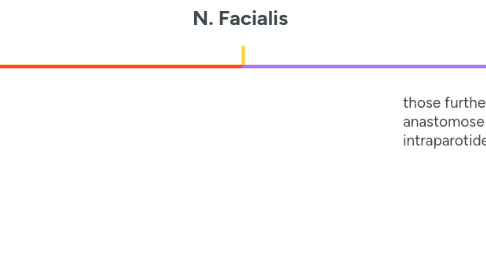
1. Introduction
1.1. Innervates?
1.1.1. facial expression (of face, scalp & external ear) / stapedius muscle / stylohyoid muscle / post. belly of digastric muscle
1.1.2. taste buds of the ant. 2/3 of tongue / soft palate (by SVA fibers)
1.1.3. part of the external acustic meatus (skin) (by GSA fibers)
1.1.4. Submandibular + sublingual gland / mucous glands of oral/nasal cavities / lacrimal gland - GVE
1.2. Course
1.2.1. pontocerebellar angle
1.2.1.1. posterior cranial fossa
1.2.1.1.1. enters internal acoustic meatus
1.2.2. Has 2 roots
1.2.2.1. Large motor root - SVE
1.2.2.2. Smaller sensory root
1.2.2.2.1. intermediate nerve
1.2.2.3. usually accompany each other until facial canal?
1.2.2.3.1. fuse to form n.facilais
1.3. Nuclei
1.3.1. 1. Motor - nucl. n. facialis
1.3.1.1. all muscles of facial expression, and stapedius, stylohyoid, and posterior belly of digastric muscle **(SVE)**
1.3.2. 2. Superior salivatory nucleus
1.3.2.1. parasympathetic inn. of all salivary glands except parotid gland; all glands in mucous membranes assoc.with the oral & nasal cavities; lacrimal gland **(GVE)**
1.3.3. 3. Gustatory nucleus – rostral part of nuclei tractus solitarius
1.3.4. 4. Spinalis nervi trigemini
1.3.4.1. skin of the part of external acustic meatus synapse in this nucleus **(GSA)**
1.4. Ganglion
1.4.1. at the sharp bend - sensory ganglion located
1.4.1.1. contains
1.4.1.1.1. pseudounipolar neurons for the chorda tympani and n. petrosus major (taste fibers; SVA)
1.4.1.1.2. pseudounipolar neurons for some GSA fibers (skin; posterior auricular nerve)
2. Receives impulses from the chorda tympani and n. petrosus major; taste from anterior two-thirds of the tongue & palatum molle) **(SVA)**
3. & arrives into the infratemporal fossa where it joins the lingual nerve (branch of mandibular nerve, N. V)
3.1. provides
3.1.1. parasympathetic innervation for the submandibular & sublingual glands & the lingual glands of the tongue (GVE fibers)
3.1.2. the SVA fibers that convey taste sensation from ant. 2/3 of the tongue
3.1.3. Brings to the lingual nerve:
3.1.3.1. 1. preganglionic PS fibers which then emerge from the lingual nerve in the submandibular triangle
3.1.3.1.1. & enter the PS submandibular ganglion.
3.1.3.2. 2. the taste fibers (SA) from chorda tympani just pass through lingual nerve
3.1.3.2.1. without any connection to the submandibular ganglion & are distributed with the terminal branches of the lingual nerve.
4. those further divide and anastomose forming thus plexus intraparotideus
5. Branches
5.1. Within facial canial
5.1.1. N. Petrosus major
5.1.1.1. 1st branch
5.1.1.1.1. at the geniculum, runs anteromedially toward ant. surface of the pars petrosa
5.1.1.2. Cariries preganglionic parasympathetic fibers to the pterygopalatine ganglion (GVE fibers:
5.1.1.2.1. salivary glands in the upper half - oral cavity
5.1.1.2.2. mucous glands in the nasal cavity
5.1.1.2.3. carries some taste fibers from the soft palate in the lesser palatine nerve (SVA fibers)
5.1.2. N. Stapedius
5.1.2.1. from third (mastoid) part of the facial canal
5.1.2.1.1. stapedius muscle attached to the stapes (SVE fibers).
5.1.3. Chorda Tympani
5.1.3.1. branches off inferiorly to stapedius nerve
5.1.3.1.1. enters the tympanic cavity through its posterior wall
5.2. Extracranial
5.2.1. 1. N. auricularis posterior
5.2.1.1. Post belly of m. occipitofrontalis / auricular muscles
5.2.2. 2. N. Digastricus
5.2.2.1. Post belly of m. digastricus + stylohyoid muscle
5.2.3. Plexus intraparotideus
5.2.3.1. 3 branches
5.2.3.1.1. when enter, n.7, divided into upper & lower branches.
5.2.4. 5 terminal branches
5.2.4.1. Temporalis
5.2.4.2. Zygomatic
5.2.4.3. Buccales
5.2.4.4. Marginalis mandibularis
5.2.4.5. Cervicales
5.2.5. PS ganglion
5.2.5.1. pterygopalatal ganglion - maxillary nerve submandibular ganglion - mandibular nerve
5.2.6. G. Pterygopalatinum
5.2.6.1. N. PETROSUS MAJOR carries preganglionic PS to Ganglion
5.2.6.2. • PG S fibers arrive to pterygopalatal ganglion via n. petrosus profundus • (together those two nerves fuse to form n. canalis pterygoidei)
5.2.6.3. PG PS fibers originating in G, + PG S fibers passing through this ganglion, join fibers from the RAMI GANGLIONARES of n. maxillaris to form: • orbital, palatine , nasal & pharyngeal branches that leave pterygopalatal ganglion
5.2.6.3.1. DIDNT UNDERSTAND
5.2.6.4. others pass superiorly through r.ganglionares of n.maxillaries
5.2.6.4.1. main trunk n.maxillaris
